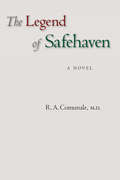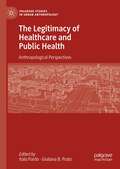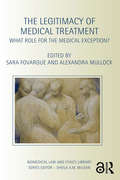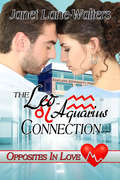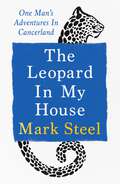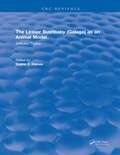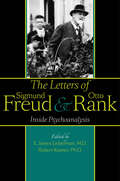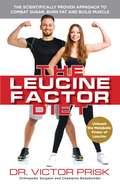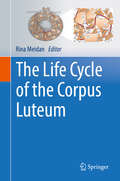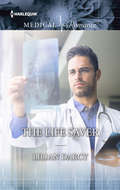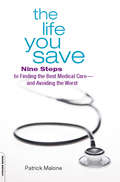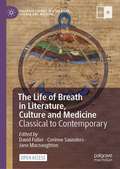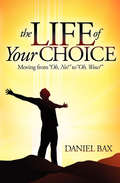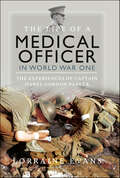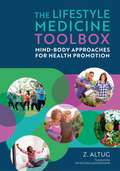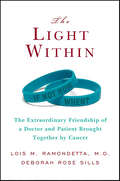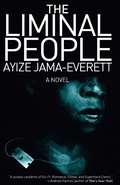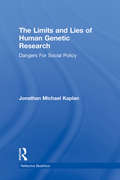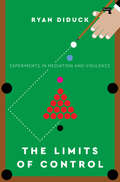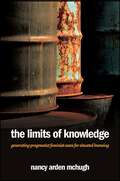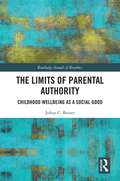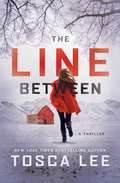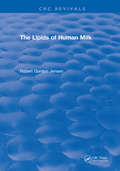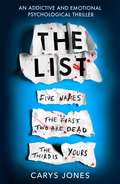- Table View
- List View
The Legend of Safehaven: A Novel
by R. A. ComunaleThe sequel to R. A. Comunale's highly praised first novel Requiem for the Bone Man follows the continuing story of Dr. Robert Galen and his friends, Robert and Nancy Edison, as they adjust to semiretirement on a mountaintop in northeastern Pennsylvania, raising and caring for the three orphaned Hidalgo children they rescued and adopted. Along the way, the six residents of the mountain interact with a variety of individuals--human and animal--who also are seeking sanctuary, and even redemption, on the property that becomes known as Safehaven. In ways mystical, magical, and even heroic, Comunale once again envelops readers in a fictional world that is often harrowing, but always captivating.
The Legitimacy of Healthcare and Public Health: Anthropological Perspectives (Palgrave Studies in Urban Anthropology)
by Italo Pardo Giuliana B. PratoThe complex, highly problematic, often thorny dynamics of trust and authority are central to the anthropological study of legitimacy. In this book, this sine qua non runs across the in-depth examination of the ways in which healthcare and public health are managed by the authorities and experienced by the people on the ground in urban Europe, the USA, India, Africa, Latin America and the Far and Middle East. This book brings comparatively together anthropological studies on healthcare and public health rigorously based on in-depth empirical knowledge. Inspired by the current debate on legitimacy, legitimation and de-legitimation, the contributions do not refrain from taking into account the impact of the Covid-19 pandemic on the health systems under study, but carefully avoid letting this issue monopolise the discussion. This book raises key challenges to our understanding of healthcare practices and the governance of public health. With a keen eye on urban life, its inequalities and the ever-expanding gap between rulers and the ruled, the findings address important questions on the complex ways in which authorities gain, keep, or lose the public’s trust.
The Legitimacy of Medical Treatment: What Role for the Medical Exception? (Biomedical Law and Ethics Library)
by Sara Fovargue Alexandra MullockWhenever the legitimacy of a new or ethically contentious medical intervention is considered, a range of influences will determine whether the treatment becomes accepted as lawful medical treatment. The development and introduction of abortion, organ donation, gender reassignment, and non-therapeutic cosmetic surgery have, for example, all raised ethical, legal, and clinical issues. This book examines the various factors that legitimatise a medical procedure. Bringing together a range of internationally and nationally recognised academics from law, philosophy, medicine, health, economics, and sociology, the book explores the notion of a treatment, practice, or procedure being proper medical treatment, and considers the range of diverse factors which might influence the acceptance of a particular procedure as appropriate in the medical context. Contributors address such issues as clinical judgement and professional autonomy, the role of public interest, and the influence of resource allocation in decision-making. In doing so, the book explores how the law, the medical profession, and the public interact in determining whether a new or ethically contentious procedure should be regarded as legitimate. This book will be of interest and use to researchers and students of bioethics, medical law, criminal law, and the sociology of medicine. Chapter 6 of this book 'Family perspectives on proper medical treatment for people in prolonged vegetative and minimally conscious states' by Celia Kitzinger and Jenny Kitzinger is available under an open access CC BY NC ND license and can be viewed at: http://preview.ncbi.nlm.nih.gov/books/prevqa/NBK199156/ .
The Leo-Aquarius Connection (Opposites in Love, Medical Zodiac Romances #5)
by Janet Lane WaltersThe nurses stare as he exits the elevator on the Pediatric Unit. “Enter the handsome doctor.” Those are Doctor Caleb Winstone’s words as he steps off the elevator. Though he’s embarrassed, this Leo doctor rolls with the punches. He’s returned home to join an older doctor in the practice. Before long he learns the new nurse manager of the unit is a woman he knows. Of all the women in the world, she is the last one he wants to see. How can he manage to work daily with her? Before the day ends, he discovers his mother has decided who he should marry and the woman is quite willing. Not for him. Suzanna Rollins is an Aquarian and now the guardian of her half-brother who was badly injured in a car accident. She takes the position as nurse manager of the Pediatric unit for several reasons. One is the move from the city re-unites her with college friends, the Grantley Gang. The other is for the excellent Rehab Center. On the day of her arrival, she encounters Caleb. What is he doing here and why? Can she work with the man she fell in and out of love with the night he offered her less than marriage? Caleb’s interest in helping her half-brother gives them more together time than they imagined.
The Leo-Aquarius Connection (Opposites in Love, Medical Zodiac Romances #5)
by Janet Lane WaltersThe nurses stare as he exits the elevator on the Pediatric Unit. “Enter the handsome doctor.” Those are Doctor Caleb Winstone’s words as he steps off the elevator. Though he’s embarrassed, this Leo doctor rolls with the punches. He’s returned home to join an older doctor in the practice. Before long he learns the new nurse manager of the unit is a woman he knows. Of all the women in the world, she is the last one he wants to see. How can he manage to work daily with her? Before the day ends, he discovers his mother has decided who he should marry and the woman is quite willing. Not for him. Suzanna Rollins is an Aquarian and now the guardian of her half-brother who was badly injured in a car accident. She takes the position as nurse manager of the Pediatric unit for several reasons. One is the move from the city re-unites her with college friends, the Grantley Gang. The other is for the excellent Rehab Center. On the day of her arrival, she encounters Caleb. What is he doing here and why? Can she work with the man she fell in and out of love with the night he offered her less than marriage? Caleb’s interest in helping her half-brother gives them more together time than they imagined.
The Leopard in my House: One man’s adventures in cancerland
by Mark Steel'A deep, personal, clever and witty book' Michael Rosen | 'Funny, moving, wise and then very funny again' John O'Farrell | 'clear-eyed, humane and engaging' Observer | 'inspiring' GuardianI feel like there’s a leopard in my house, locked in a room. I’ve contacted the leopard authorities and they assure me they are used to dealing with leopards like this, and they have a plan for removing the leopard. It will take a while, though, and once in a while I can hear it growl.And that’s all very reassuring. Even so, several times a day I think to myself: “Hang on, there’s a leopard in my house.”One morning, while shaving, the comedian Mark Steel noticed that one side of his neck seemed larger than the other. After a whistlestop tour of assorted medical professionals, a consultant delivered the ominous words that would define the next months of his life: ‘I’m afraid it’s not good news, Mr Steel’.And so began a journey into the heart of the NHS, as he embarked on the long and uncertain road to cancer recovery via a range of mildly torturous and entirely miraculous treatments. What, if anything, might he learn about himself – and our capacity for coping with life when times get tough – as he becomes part of a club that one in two British people will ultimately join?A frank and funny diary of one man’s rather trying year, this is an unforgettable and uplifting story of getting ill, getting on with it, and getting better.
The Lesser Bushbaby (Galago) as an Animal Model: Selected Topics
by Duane E. HainesIt is not the goal of the present volume to promote Galago as an animal model, but to alert investigators to the potential thereof. In this respect, this collection of papers serves as a general introduction. The subjects covered are purposefully broad so as to illustrate that Galago not only has been, but may be, utilized with success in a variety of research areas. Most papers deal with the pros and cons of utilizing Galago in a specific line of research and in many instances discuss potential problems which may arise. The established value of the lesser bushbaby in particular reseach endeavour is also discussed and illustrated by some contributors.
The Letters of Sigmund Freud and Otto Rank: Inside Psychoanalysis
by E. James Lieberman Gregory C. RichterSigmund Freud’s relationship with Otto Rank was the most constant, close, and significant of his professional life. Freud considered Rank to be the most brilliant of his disciples. The two collaborated on psychoanalytic writing, practice, and politics; Rank was the managing director of Freud’s publishing house; and after several years helping Freud update his masterpiece, The Interpretation of Dreams, Rank contributed two chapters. His was the only other name ever to be listed on the title page. This complete collection of the known correspondence between the two brings to life their twenty-year collaboration and their painful break.The 250 letters compiled by E. James Lieberman and Robert Kramer humanize and dramatize psychoanalytic thinking, practice, and organization from 1906 through 1925. The letters concern not just the work and trenchant contemporaneous observations of Freud and Rank but also their friendships, supporters, rivals, families, travels, and other personal and professional matters. Most interestingly, the letters trace Rank’s growing independence, the father-son schism over Rank’s "anti-Oedipal" heresy, his surprising reconciliation with Freud, and the moment when they parted ways permanently. A candid picture of how the pioneers of modern psychotherapy behaved with their patients, colleagues, and families—and each other—the correspondence between Freud and Rank demonstrates how psychoanalysis developed in relation to early twentieth-century science, art, philosophy, and politics.A rich primary source on psychiatry, history, and culture, The Letters of Sigmund Freud and Otto Rank is a cogent and powerful narrative of early psychoanalysis and its two most important personalities.
The Leucine Factor Diet: The Scientifically-proven Approach To Combat Sugar, Burn Fat And Build Muscle
by Victor PriskTHE ULTIMATE GUIDE TO THE POWERFUL AMINO ACID THAT SUPERCHARGES YOUR METABOLISM If your goal is to improve strength and vitality, sugar is the kryptonite that will hold you back. Fortunately, nature has provided the ultimate anti-sugar: leucine. This book reveals the amazing ability of leucine to combat the harmful effects of sugar, burn deep levels of fat and rapidly build muscle. With advice on getting started, building a personalized plan and successfully reaching your goals, The Leucine Factor Diet offers you a path for becoming healthy, strong and lean. Author Dr. Victor Prisk, an orthopedic surgeon, champion gymnast and bodybuilder, teaches how to optimize the leucine content of your food while creating nutritious and delicious meals. With detailed information on dietary supplements, resistance exercise and medical awareness, The Leucine Factor Diet brings together all the key elements to successful muscle building. Whether you are a competitive athlete or weekend warrior, this book has everything you need to take your fitness to the next level.
The Life Cycle of the Corpus Luteum
by Rina MeidanThe book is describes the life cycle of a unique endocrine gland that is absolutely essential for the establishment and maintenance of pregnancy in all mammalian species. The corpus luteum is unique because it is formed and destroyed every (non-fertile) reproductive cycle. When fertilization occurs, the corpus luteum is rescued or maintained. The processes that control corpus luteum formation, demise (luteolysis), or maintenance are just beginning to be unraveled in recent years; they involve diverse cell types and mechanisms. Some of these processes resemble tumor development--angiogenesis, for instance--but interestingly enough, this resemblance is only up to a point. The corpus luteum uses mechanisms that allow its normal, physiological growth and disappearance. Pulling together key research on the corpus luteum, this volume is of interest to both reproductive endocrinologists and comparative physiologists, with clinical relevance spanning comparative animal studies to women's health.
The Life Saver
by Lilian DarcyComing soon! The Life Saver by Lilian Darcy will be available Nov 1, 2016.
The Life You Save: Nine Steps to Finding the Best Medical Care-and Avoiding the Worst
by Patrick MalonePatient advocate Patrick Malone shows you how to get the best medical care and how to avoid being a victim of malpractice
The Life of Breath in Literature, Culture and Medicine: Classical to Contemporary (Palgrave Studies in Literature, Science and Medicine)
by David Fuller Jane Macnaughton Corinne SaundersThis open access book studies breath and breathing in literature and culture and provides crucial insights into the history of medicine, health and the emotions, the foundations of beliefs concerning body, spirit and world, the connections between breath and creativity and the phenomenology of breath and breathlessness. Contributions span the classical, medieval, early modern, Romantic, Victorian, modern and contemporary periods, drawing on medical writings, philosophy, theology and the visual arts as well as on literary, historical and cultural studies. The collection illustrates the complex significance and symbolic power of breath and breathlessness across time: breath is written deeply into ideas of nature, spirituality, emotion, creativity and being, and is inextricable from notions of consciousness, spirit, inspiration, voice, feeling, freedom and movement. The volume also demonstrates the long-standing connections between breath and place, politics and aesthetics, illuminating both contrasts and continuities.
The Life of Your Choice: Moving from ''Oh, No!'' to ''Oh, Wow!''
by Daniel BaxA remarkable story of recovering from a shattering accident—and how the author achieved what others said was impossible.This is the story of a man who miraculously woke up after a catastrophic accident left him unable to talk or eat, with his left side completely paralyzed, and with no memories of his past or who he was. He spent the next five years piecing together his past and relearning how to speak, eat, and walk—all things the doctors had assured his family he would never do again.This book gives us his story and the methods he used to achieve what conventional wisdom said was impossible—and serves as an inspiring, helpful guide for readers who want to replicate his success in their own lives.
The Life of a Medical Officer in World War I: The Experiences of Captain Harry Gordon Parker
by Lorraine EvansThe Life of a Medical Officer in WW1 documents the experiences of Captain Harry Gordon Parker and provides a rare insight into the conflict that engulfed Europe from 1914-1918. Having joined the Naval Medical Service as a Royal Navy Temporary Surgeon, Parker's first taste of war was aboard a hospital evacuation ship, which regularly crossed the English Channel, from Southampton to France, picking up casualties from the battle grounds. Somewhat disillusioned with the whole experience, he requested a transfer to the Royal Medical Army Corps and soon found himself transported to the trenches in France. It was here, first serving with the Lancashire Fusiliers and then later as permanent Regimental Medical Officer with the 2nd Manchester’s Regiment, that he spent the remainder of the war, witnessing first-hand the horrors of Passchendaele, Arras and the Somme. Parker's account not only reveals a record of the conflict, but also encompasses a totality of military life as it impacted on the medical fraternity. From bureaucratic red tape, lack of medical supplies, lice infestations, trench foot and absurd missions where the incompetence of his own side was as dangerous as the enemy, his thoughts are penned with sincerity, the utmost compassion as well as a certain degree of sardonic humor: ‘We went into the trenches for the first time at Givenchy. It snowed heavily, and our rations did not arrive. The Royal Welsh, however, generously shared their rations with our men, who repaid the kindness by (accidentally) shooting one of the Sergeants through the stomach!’. With endorsement from family members, author Lorraine Evans has revised Parker’s notes and scribblings for clarity and added complementary text to provide historical background. What transpires is a lasting and classic chronicle, an extraordinary human account of history as it ensued.
The Lifestyle Medicine Toolbox: Mind-Body Approaches for Health Promotion
by Ziya Altug, OCSThis holistic guide provides an integrative toolbox on how healthcare and fitness professionals can promote lifestyle medicine with their clients. Its clinical and evidence-informed approach focuses on the six primary lifestyle medicine factors: nutrition, exercise, sleep hygiene, stress management, risky substance use, and social connectedness. Each factor is enriched with a variety of strategies and advice including anti-inflammatory recipes, self-guided visualisation, tips on how to break bad habits, sustainable fitness, and mind-body exercises.Based on the author's 30+ years of experience as a trained physical therapist treating musculoskeletal conditions, this book's nonpharmacological and nonsurgical focus allows clients to feel empowered in taking charge of their health through a plethora of resources and techniques. It provides clear, actionable steps and real-world examples in order to nurture sustainable changes that promote long-term health and healing.
The Light Within: The Extraordinary Friendship of a Doctor and Patient Brought Together by Cancer
by Lois M. Ramondetta Deborah Rose SillsThe luminous true story of a friendship that shed the boundaries of the doctor-patient relationship and became less a confrontation with death than a celebration of the joys of life When young gynecologic oncology fellow Lois Ramondetta was first summoned to the room of a new patient, neither she nor the forty-nine-year-old professor of religion she encountered named Deborah Sills thought they had much in common. They certainly had no idea that they were about to embark on a transcendent odyssey that would become a soul-deep friendship. Now their heartfelt story, The Light Within, follows these two women through a decade of friendship and "big lives"—husbands, children, friends, and careers—ultimately crossing the country and traveling to foreign lands, where they spoke and wrote together about the intersection of doctors, patients, and spirituality. Both women searched together and openly for answers with honesty and intimacy until Deborah passed away in the spring of 2006.
The Liminal People
by Ayize Jama-EverettWhen his ex asks for help, Taggert risks the wrath of his enigmatic master to try and save her daughter. But as Taggert realizes the girl has more power than even he can imagine, he has to delve into the very nature of own skills and utilize his heart and soul to survive. Ayize Jama-Everett was born and raised in Harlem, New York. He has traveled in Northern Africa, New Hampshire, and northern California. He holds a master's degree in clinical psychology and a master's in divinity. When not educating or studying, he's usually enjoying aged rums and practicing his aim.
The Limits and Lies of Human Genetic Research: Dangers For Social Policy (Reflective Bioethics)
by Jonathan Michael KaplanIn The Limits and Lies of Human Genetic Research, Jonathan Kaplan weighs in on the controversial subject of the roles genes play in determining aspects of physical and behavioral human variation. Limits and Lies makes the case that neither the information we have on genes, nor on the environment, is sufficient to explain the complex variations among humans.
The Limits of Control: Experiments in Mediation and Virulence
by Ryan DiduckRyan Diduck turns his attention to control societies and their protocols in the wake of the global COVID-19 pandemic. What are the political implications of government measures to combat Coronavirus?The end of the world as we know it is no longer imaginary.Severe acute respiratory syndrome Coronavirus 2 (also known as SARS-CoV-2 or COVID-19) is a potent virus that is upturning nearly every aspect of life on earth. But the novel Coronavirus is more than just a virus. It is a marketplace and media event, too, broadcasting at speed, oscillating against the transmission of its mediations. Ultimately, COVID-19 is the pretext upon which nations around the world have enacted social controls of varying severity, strictly limiting the communication, movement, and daily activities of billions of people. This could be a moment of overwhelming consolidation of capital. Or it could further reveal the cracks in a system which has exacerbated the coronavirus pandemic. We are rapidly approaching the limits of control. In the tradition of William S. Burroughs, Naomi Klein, Mark Fisher, and other key theorists of discipline and jurisdiction, The Limits of Control offers a timely new analysis of control societies, and a sibylline roadmap for living together in a hypervirulent world. What we imagine from now on has never mattered more.
The Limits of Knowledge: Generating Pragmatist Feminist Cases for Situated Knowing
by Nancy Arden McHughThe Limits of Knowledge provides an understanding of what pragmatist feminist theories look like in practice, combining insights from the work of American pragmatist John Dewey concerning experimental inquiry and transaction with arguments for situated knowledge rooted in contemporary feminism. Using case studies to demonstrate some of the particular ways that dominant scientific and medical practices fail to meet the health needs of marginalized groups and communities, Nancy Arden McHugh shows how transactionally situated approaches are better able to meet the needs of these communities. Examples include a community action group fighting environmental injustice in Bayview Hunters Point, California, one of the most toxic communities in the US; gender, race, age, and class biases in the study and diagnosis of endometriosis; a critique of Evidence-Based Medicine; the current effects of Agent Orange on Vietnamese women and children; and pediatric treatment of Amish and Mennonite children.
The Limits of Parental Authority: Childhood Wellbeing as a Social Good (Routledge Annals of Bioethics)
by Johan C. BesterThis book offers a novel theory of childhood well-being as a social good. It re-examines our fundamental assumptions about parenting, parental authority, and a liberal society’s role in the raising of children. The author defends the idea that the good of a child is inexorably linked to the good of society. He identifies and critiques the problematic assumption that parenting is an extension of individual liberty and shows how we run into problems in medical decision-making for children because of this assumption. He develops an objective conception of what is good for a child in a liberal society, drawing on the assumptions of liberty, and from here constructs a set of things that society and its members owe children. There are ways in which society should support and intervene in parental decisions to guarantee a child’s well-being. Ultimately, raising children is a social activity that requires input from society. The author then applies this theory of childhood well-being to develop a framework for medical decision-making for children. He also uses practical examples, such as vaccinations, parental leave, and healthcare access, to demonstrate the implications of his theory for public policy. The Limits of Parental Authority: Childhood Wellbeing as a Social Good will be of interest to practitioners, scholars, and advanced students working in bioethics, political philosophy, and public health policy.
The Line Between: A Novel (The Line Between #1)
by Tosca LeeIn this frighteningly believable thriller from New York Times bestselling author Tosca Lee, an extinct disease re-emerges from the melting Alaskan permafrost to cause madness in its victims. For recent apocalyptic cult escapee Wynter Roth, it’s the end she’d always been told was coming.When Wynter Roth is turned out of New Earth, a self-contained doomsday cult on the American prairie, she emerges into a world poised on the brink of madness as a mysterious outbreak of rapid early onset dementia spreads across the nation. As Wynter struggles to start over in a world she’s been taught to regard as evil, she finds herself face-to-face with the apocalypse she’s feared all her life—until the night her sister shows up at her doorstep with a set of medical samples. That night, Wynter learns there’s something far more sinister at play and that these samples are key to understanding the disease. Now, as the power grid fails and the nation descends into chaos, Wynter must find a way to get the samples to a lab in Colorado. Uncertain who to trust, she takes up with former military man Chase Miller, who has his own reasons for wanting to get close to the samples in her possession, and to Wynter herself. Filled with action, conspiracy, romance, and questions of whom—and what—to believe, The Line Between is a high-octane story of survival and love in a world on the brink of madness.
The Lipids of Human Milk
by Robert Gordon JensenMethods for determining, isolating and identifying human milk lipids, together with problems associated with sampling and analysis, are described in some detail in the first 3 chapters of this book. Factors affecting total lipid content of human milk, lipid classification, fatty acids, the milk fat globule membrane, fat-soluble vitamins and nutritional aspects of human milk lipids are also extensively reviewed in Chapters 4-9.
The List: ‘A terrifyingly twisted and devious story' that will take your breath away
by Carys JonesFive names on a list. The first two are dead.The third is yours.A rip-roaring, addictive, intense and emotional thriller for fans of Lucy Foley, Ruth Ware, Phoebe Morgan, CL Taylor and Lisa Jewell...* * * * * * *Beth Belmont runs every day, hard and fast on the trail near home. She knows every turn, every bump in the road. So when she spots something out of place - a slip of white paper at the base of a tree - she's drawn to it.On the paper are five names. The third is her own.Beth can't shake off the unease the list brings. Why is she on it? And what ties her to the other four strangers?Then she discovers that the first two are dead.Is she next?Delving into the past of the two dead strangers, the truth Beth finds will lead her headlong into her darkest, deadliest and most dangerous nightmares...PRAISE FOR THE LIST:'Compelling, unsettling and utterly addictive, The List got deep under my skin as I read it in a single sitting' M W CRAVEN, author of The Puppet Show'A sharp psychological thriller. A captivating premise and an engrossing read with twists and turns that will keep you hooked to the very last page' ADAM HAMDY, author of Black 13'A terrifying story of guilt and remorse. A chilling reminder that the past doesn't always stay there no matter what stories we tell ourselves or others! The truth sits in the shadows and will always come to light' ALEX HART, author of Take Me Home
